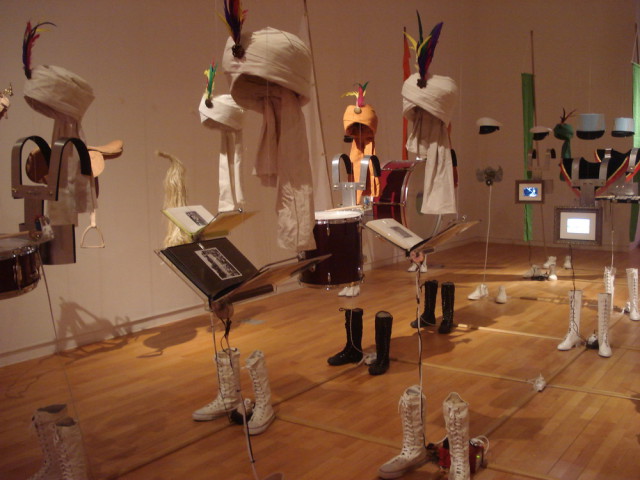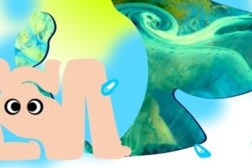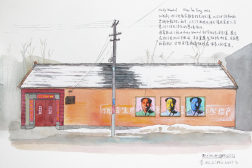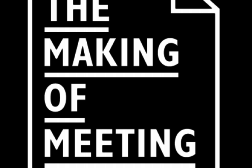

Third Realm: A Special Project by Jompet Project for the Gervasuti Foundation
Opening: June 4th, 2011 from 2:00 to 9:00 pm
Dates: June 5th to September 29th, 2011
Hours: Tuesday to Sunday 10:30 am to 6:00 pm | closed on Mondays
Location: Fondamenta S. Ana (Via Garibaldi) Castello 993
Press release please click here.
How much further to the East do we have to venture in order to understand and re-decipher the West? How much more attention should we pay to a nation’s degrees of colonial coding with a view to revealing its democratization process? What if an artist were to employ a historian’s research strategy in the search for a ‘third reality’?
ArtHub Asia and the Gervasuti Foundation are proud to host Indonesian artist, Jompet (Kuswidananto), during the Venice Biennale this year. Jompet’s site-specific projects deliberately play with the notion of subversion. The artist tackles universally accepted opposites such as colonial versus post-colonial, conservative vs. modern, democracy vs. autocracy, thereby constructing a ‘new cultural paradigm’ and creating a “grey space.” Once renowned as the world’s first international trade centre, where far-flung cultures from Asia and Europe intermingled, despite the cynical tolerance of its inhabitants, the city of Venice itself invites a multicultural exploration from within.
Based in Yogyakarta, Jompet has become known for his delicate multimedia installations that often combine video, sound and kinetic sculptures. For the occasion of the Biennale, the artist has constructed a project titled: Third Realm, a site specific project by Jompet (Kuswidananto). The installation work is based on the idea of phantoms: the artist has literally constructed mechanized ghostly figurines and positioned them in such a way as to recall a parade-like organization. Is this the new Venetian carnival? Yet these figures are neither embodied, nor flamboyantly masked. Instead, they relinquish their bodies, featuring only fragments–a hat, a few garments similar to colonial military dress, a pair of shoes–all suspended from the ceiling. Some of them have drum kits that periodically beat a sporadic percussion.
Presented during ArtHub Asia’s Silk Roads symposium held in Bangkok in 2009 after its first appearance at Yokohama Triennale, the installation represents Jompet’s personal journey through the complex, colonial history of Indonesia and Java and is the result of his long standing research into the compendium of psychosomatic traces of a bloody past. His work is also a fragile description of the integrated nature of Java’s many identities—a land of many people and languages where religious syncretism brings Christianity, Islam, Hinduism, Buddhism and animism together. Positioned within Venetian arches and interiors, the installation is set to tackle not only the repercussions of national identity and religion-based politics, but also the very foundations of democracy and its homogenizing effects upon society.
Jompet is the kind of artist that ArtHub Asia has been promoting, supporting and collaborating with. Tectonic shifts across social-political systems are upon us and this project presents an irresistible opportunity to help break through some of the static that exists in the reading of East vs. West. Disseminating its voice and platform now, to and across Venice, ArtHub Asia treads on the borders of new territories of challenge. After all, this is the site where one of the co-authors of this text set out on his journey to the East twenty years ago; this is also the site where the other co-author felt the Byzantine puzzle complete.
The Gervasuti Foundation is located in the heart of Venice—the ideal place for Jompet’s ghostly figures to disembark. The Gervasuti Foundation is an alternative interdisciplinary art platform promoting an experimental Preservation-Through-Change Project which aims to be both local and international: preserving the uniquely inventive and rich cultural traditions of Venetian history through the promotion and production of interdisciplinary contemporary art practice. This project marks the first collaboration between ArtHub Asia and Gervasuti Foundation and we thank Fiona Biggiero for her incredible energy and trust in the project along with her partners. We believe that this is only the first step in a long-term collaboration.
Without the genius of Jompet, this site specific project would not be here today and we would like to thank him for his dedication to the project.
We would also like to thank Alia Swastika and Ark Galerie for their support. We are grateful to FarEastFarWest for making this project feasible and to all the partners that supported us along the way.
Third Realm, a site specific project by Jompet Kuswidananto
Written by Jompet Kuswidananto, May 2011. Parts of this text is written by Yudi Ahmad Tajudin and Jompet Kuswidananto for, “Third
Realm,” a solo show of Jompet in Parasite, Hong Kong, 2010.
The history of Indonesia, as part of the developing world and former colonized countries, can be read as a narrative of a nation that is perpetually in an “in-between” situation or state of transition. From pre-colonial to colonial periods, colonial to post-colonial, agrarian culture to industrial, from industrial to post-industrial information era, from rural culture to urban ethos.
It is a culture that is located between two spaces: between the traditional and the modern, the original and the alien, the inside and the outside, the high brow and the low brow. It never makes the complete transition from one cultural space to another, instead it builds on a mix (and excess) of cultures—its “body” consisting of many different cultural layers.
Indonesia’s remarkable culture raises many questions:
How are subjects or spaces formed ‘in between,’ or in excess of the sum of the parts? How is the notion of subjectivity and spatiality formulated where the exchange of values, meanings and priorities may not always be collaborative and dialogical, but may be profoundly antagonistic and even incommensurable?
Referring to the spatial realities and identity formulation developing and persisting in Java, the answers to these questions may be evident in the creation of a third reality–a third space, third body or identity. The third reality is a hybrid reality. A reality made from a blend of many things. The third reality is a post-colonial/third world/Indonesian reality composed from elements that are contradictory, unfinished, half-done, confusing and transitional or liminal.
As a metaphor, the third reality is a temporary and flexible term that attempts to capture what is actually a constantly shifting and changing milieu of ideas, events, performances and meanings. Pertinent to the understanding of the metaphors is the insight that there is not just one single definition of body and identity but rather a multitude of approaches and perspectives.
In Java, for example, one can be a Muslim and a Javanese animist at the same time; one can be local and global; modern and traditional. One can exist in the space in-between different things.
As Homi K Babha once said: “The ‘in-between’ space provides the terrain for elaborating strategies of self-hood, singular or communal, that initiate new signs of identity and innovative sites of collaboration, and contestation, in the act of defining the idea of society itself.”
Java Machine, a struggle against identity domination
An interview with Jompet by Davide Quadrio and Defne Ayas
Can you give a short introduction about your work in relationship with Java and its political development?
First of all, the ‘Java’ in my work is a door I provide for people to enter the field of intersection of different beliefs and cultures, where continuous contestations, juxtapositions, and negotiation between them have been putting layers and more layers on the face of the world culture today.
As has happened elsewhere, the idea of homogenization is now emerging in Indonesia since the full embrace of democracy of 1998. This idea take shape on religious radicalism movements in one side and Globalized capitalism on the other side, they both based their thoughts on the homogeneity of the country.
Indonesian democracy actually has paved the way for increased radicalism and fundamentalism toward homogenization and victims have fall. Java is struggling very hard with this issue now, a struggle against identity domination.
In Java Machine’s series phantoms of a military past comes back to life in a sort of parade of the absurd, the phantoms of an imperialist past? How do you define it?
Java Machine is adopting the form/appearance/figure of the royal army, as can be found in Java’s centre of excellence (Jogiakarta and Solo). We could see the form and practice of Java’s royal army as a portrayal of how Javanese syncretism try to merge divergent beliefs and cultures that keep coming to Java. Since the middle of 18th century, when the Dutch colonization had already intervened in cultural and political affairs of Javanese kingdoms, Java’s royal army doesn’t have military function any longer. Their existence only serves symbolic prominence. Their costumes collages of various cultures and tradition: Hindu, Islam, the West and local traditions.
However, here is the new battle for Javanese army, a battle of symbols. The appearance of the army, somehow, shows us how hard they have been working on managing different symbols on their body. It’s a battle taking place on the body of the army, a battle that actually happened to any living bodies today.
The army, as many people in our time, keep doing it from time to time and through this way they (we) celebrate the changes. The phantoms/hollowness reflecting the liquidity of an identity which always changes its ‘shape’ from time to time as the interaction and negotiation between cultures is continuously ongoing.
Can you explain how you connect some of the “ethnical” symbolic parts of your works with the contemporary Indonesia? Why do you think is relevant?
Basically, I am not really concerned with the ‘ethnicity’ of the symbols, I am more concerned about the use of public artifacts as a tool to invite people’s empathy to be a part of the issue I raise.
Traditional artifacts as well as contemporary artifacts are staying in the same space and time today. And so is the Javanese/Indonesian society, they always step their feet on both traditional and contemporary culture. In this situation, so far, I think I can invite people to enter deeper in the high tension of today’s issue beyond the artifacts rather than standing still staring at the beauty of those ancient shapes.
Around the world, Indonesia is known as the place for vacation symbolized by the omnipresent Bali and the Islamic country. In your work there are many references of religions that are mixed in a syncretic way: there are references to Christian, Islamic, Buddhist, Hindu and Animistic traditions. Can you give as a short explanation of the complexity of the religious situation in Indonesia and especially in Java?
It is important to see the religious journey in Java to understand the cultural odyssey (or vice versa). One of the most important issues in my work is ‘syncretism.’ Syncretism in Java happened to be a strategy, even a system, in an attempt to reconcile, to manipulate, or to overcome disparate or contradictory beliefs; between the ‘old’ and the ‘new,’ the ‘genuine’ and the ‘alien,’ the ‘traditional’ and the ‘modern;’ between ‘us’ and ‘the other.’
Looking back to the history, Java society and culture has gone through several big changes. It was about in the beginning of the century when local animist of Java met Indian Hinduism followed by Buddhism a few centuries later, then there was a big conversion to Islam in 15th Century, then Christians came along and colonization started in the 16th Century.
What actually happened is that the religion that came to Java has been modified and localized from it’s origin before it is fit for the society.
There is an important traditional saying: Agama Ageming Ati. This means: religion is clothes for the heart. Practically, as with new clothes, there has to be some adjustments on the size, materials or even colors, to make the new clothes fit the body. And later on, people in Java didn’t mind putting the old clothes off and putting on another new one, as their hearts remained the same.
In short, Java made lots of adjustments and negotiations to the religions. The adjustments were an attempt to put the local cultural facts as a base for the religious practice instead of putting the texts (Bible) as a base. Through this way the religion is more rooted to the society and also that’s why religions in Java are hybrid, genuine and unique.
The radical religious movements lately have forced them to put the texts (Bible) as the base for religious practice.
Do you read your work as a critic of the history of Indonesia? How is it?
Anyway, history always needs to be criticized.
My work, somehow, has an anthropological side. Re-looking at history is a tool like a rear view mirror in your vehicle. My work invites people to find what they and their society have in purpose to face the reality of today.
Coming to Venice and making a specific work commissioned by Arthub Asia in Gervasuti Foundation it is quite a challenge. How do you envision your work in this unknown context? What would you like your work to say in this new situation?
This new chapter of my work in Gervasuti tries to understand the cultural and political position of Java in the contemporary rhizomatic world. This work shares the experience of being in a continuous multi-level cultural and transitional environment by showing some of my notes, perspectives and artifacts, coming from the place I belong, Yogiakarta.
In the form of a ghost carnival installation, this work and myself celebrate the change: in this celebration, narratives of origins, confluences, amalgamations and different identities are accepted without favoring one to the other. It is a celebration of moments and processes that are created within the web of contesting cultures, that are in perpetual negotiations, which change and shape realities. And as a carnival, the exhibition is a celebration of embracing the difference and open them freely: like a carnival, this work takes its roots in recurring combinations and radically open perspectives.



